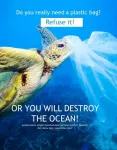(Press-News.org) Our consumer products, such as food, cosmetics and clothes, might be filled with nanomaterials - unbeknownst to us. The use of nanomaterials remains unregulated and they do not show up in lists of ingredients. This is a cause of concern since nanomaterials can be more dangerous than COVID-19 in the long term if no safety action is taken: they are tricky to measure, they enter our food chain and, most alarmingly, they can penetrate cells and accumulate in our organs.
Nanotechnology is appearing everywhere, to change our daily lives. Thanks to applications of nanotechnology, we can treat many diseases so efficiently that they'll soon be a thing of the past. We also have materials that are 100 times stronger than steel, batteries that last 10 times longer than before, solar panels that yield twice as much energy than old ones, skin care products that keep us looking young, not to mention self-cleaning cars, windows, and clothes. These used to be the stuff of science fiction and Hollywood movies, but are now the reality we live in.
Nanotechnology has the potential to become the next industrial revolution. The global market for nanomaterials is growing, estimated at 11 million tonnes at a market value of 20 billion euros. The current direct employment in the nanomaterial sector is estimated between 300,000 and 400,000 in Europe alone.
Yet, nanomaterials and their use in consumer products is far from unproblematic. A new study published in
Nature Communications today sheds light on whether they are harmful and what happens to them when they enter an organism. An international team of researchers developed a sensitive method to find and trace nanomaterials in blood and tissues, and traced nanomaterials across an aquatic food chain, from microorganisms to fish, which is a major source of food in many countries. This method can open new horizons for taking safety actions.
"We found that that nanomaterials bind strongly to microorganisms, which are a source of food for other organisms, and this is the way they can enter our food chain. Once inside an organism, nanomaterials can change their shape and size and turn into a more dangerous material that can easily penetrate cells and spread to other organs. When looking at different organs of an organism, we found that nanomaterials tend to accumulate especially in the brain," lead author Dr Fazel A. Monikh from the University of Eastern Finland says.
According to the researchers, nanomaterials are also difficult to measure: their amount in an organism cannot be measured only by using their mass, which is the standard method for measuring other chemicals for regulations. The findings emphasise the importance of assessing the risk of nanomaterials before they are introduced to consumer products in large amounts. A better understanding of nanomaterials and their risks can help policy makers to introduce stricter rules on their use, and on the way they are mentioned in products' lists of ingredients.
"It could be that you are already using nanomaterials in your food, clothes, cosmetic products, etc., but you still don't see any mention of them in the ingredient list. Why? Because they are still unregulated and because they are so small that we simply can't measure them once they're in your products," Dr Fazel A. Monikh says.
"People have the right to know what they are using and buying for their families. This is a global problem which needs a global solution. Many questions about nanomaterials still need to be answered. Are they safe for us and the environment? Where will they end up after we're done using them? How can we assess their possible risk?" Dr Fazel A. Monikh concludes.
INFORMATION:
The study was conducted in collaboration between the University of Eastern Finland (Finland), Leiden University (the Netherlands), the National Institute of Public Health and the Environment (the Netherlands), the University of South Bohemia (Czech Republic), the University of Birmingham (the United Kingdom), the Environmental Nanoscience Laboratory (India), and the University of Vigo (Spain).
For further information, please contact:
Postdoctoral Researcher Fazel A. Monikh, PhD
Email: fazel.monikh@uef.fi
Department of Environmental and Biological Sciences, University of Eastern Finland
Research article:
Particle number-based trophic transfer of gold nanomaterials in an aquatic food chain.
Fazel A. Monikh, L. Chupani, D. Arenas-Lago, Z. Guo, P. Zhang, G. Krishna Darbha, E. Valsami-Jones, I. Lynch, M. G. Vijver 1, P. M. van Bodegom & W. J.G.M. Peijnenburg. https://doi.org/10.1038/s41467-021-21164-w
The term plankton describes usually very small organisms that drift with the currents in the seas and oceans. Despite their small size, they play an important role for our planet due to their immense quantity. Photosynthesizing plankton, known as phytoplankton, for example, produce half of the oxygen in the atmosphere while binding huge amounts of carbon dioxide (CO2). Since the Southern Ocean around Antarctica is very rich in nutrients, phytoplankton can thrive there. It is therefore a key region for controlling atmospheric CO2 concentrations.
As other nutrients are abundant, scientists have ...
Exposure to radiation can wreak indiscriminate havoc on cells, tissues, and organs. Curiously, however, some tissues are more vulnerable to radiation damage than others.
Scientists have known these differences involve the protein p53, a well-studied tumor-suppressor protein that initiates a cell's auto-destruct programs. Yet, levels of this sentinel protein are often similar in tissues with vastly different sensitivities to radiation, posing the question: How is p53 involved?
A new study by researchers in the Blavatnik Institute at Harvard Medical School, Massachusetts General Hospital, and the Novartis Institutes for BioMedical Research now sheds light on this mystery.
Reporting in Nature Communications on Feb. 9, they describe how cellular survival after radiation exposure depends ...
What is the best way to monitor a brain tumor? This question is at the heart of a new Position Statement published in open-access journal Frontiers in Oncology. The article is the work of a large collaboration of UK experts and stakeholders who met to discuss the value of routinely imaging brain tumor patients to assess their tumor treatment response, which is known as "interval imaging". Their verdict: there is very limited evidence to support the practice at present. However, the article also discusses how future research could determine and maximize the value of interval ...
A new study in Frontiers in Communication has demonstrated the powerful impact that subtle messaging and cues, or 'nudges', can provide on encouraging people to show socially desirable behaviors. Travelers who were observed on the Indonesian island of Gili Trawangan, a popular tourist destination, were more likely to demonstrate environmentally conscious actions, such as refusing a plastic bag or avoiding contact with a coral reef, when they were 'nudged' towards the desirable action with either a written or face to face interaction. The researchers found that any intervention, whether framed positively or negatively, was ...
Asthma attack rates seen at GP surgeries fell significantly during the first Covid-19 pandemic lockdown of 2020, a study suggests.
Lower levels of air pollution, fewer cold and flu infections, and the fear of attending doctor surgeries due to Covid-19 were possible reasons for the 20pc drop in cases seen at GP surgeries, researchers said.
The study is the first national review of lockdown effects on asthma attacks and includes data from more than 100,000 patients.
Asthma attacks - or exacerbations - are bouts of shortness of breath, wheezing or a tight chest. There are usually more than six million GP consultations and 1400 deaths attributed to asthma in the UK every year.
For the study researchers from the University of Edinburgh looked at a national GP database ...
Higher excess COVID-19 death risk in middle-aged people with type 2 diabetes raises vaccine prioritisation questions
A largescale analysis led by the University of Exeter and funded by Diabetes UK, has found a disproportionately higher COVID-19 death risk in middle-aged people with type 2 diabetes, raising questions over vaccination strategies across Europe.
The study, accepted for publication in Diabetologia, found that compared to people of a similar age without type 2 diabetes, the additional COVID-19 mortality risk from having type 2 diabetes increases the younger someone is. Although the ...
Children aged between 5 months and 4 years attending daycare during lockdown in March to May 2020 in France had low rates of SARS-CoV-2 antibodies in their blood - known as seroprevalence - suggesting that virus infection rates were low in this population.
Research assessing seroprevalence in daycare centres that remained open during the first national lockdown in France, suggests that the rate of SARS-CoV-2 virus infection was low at 3.7%, with positive cases likely infected by an adult in their household, rather than whilst at daycare. The seroprevalence rate among daycare staff was similar to that of a control group of adults who were not exposed to children or COVID positive patients ...
In the event of a pandemic, delayed reactions and a decentralized approach by the authorities at the start of a follow-up wave can lead to longer-lasting, more severe and more fatal consequences, researchers from the universities of Zurich and Toronto have found. The interdisciplinary team compared the Spanish flu of 1918 and 1919 in the Canton of Bern with the coronavirus pandemic of 2020.
The Spanish flu was the greatest demographic catastrophe in Switzerland's recent history, causing approximately 25,000 deaths in the country during 1918 and 1919. In the wake of the current coronavirus pandemic, there has been increased public and scientific interest in the events of that time. An interdisciplinary team of researchers in evolutionary medicine, history, geography and ...
Oakland, Calif. -- An analysis of Kaiser Permanente members in Northern California early in the COVID-19 pandemic found racial and ethnic disparities in the likelihood of testing positive for the coronavirus, but no significant disparities in mortality among those who were hospitalized.
According to the study published Feb. 8 in Annals of Internal Medicine, Latino patients were nearly 4 times as likely as white patients to become infected with the virus, while Asian and Black patients were 2 times as likely to get COVID-19 as white patients. The odds of hospitalization were also higher for Latino, Asian, and Black patients with ...
PITTSBURGH, Feb. 8, 2021 - With the aid of sophisticated machine learning, researchers at UPMC and the University of Pittsburgh School of Medicine demonstrated that a tool they developed can rapidly predict mortality for patients facing transfer between hospitals in order to access higher-acuity care. This research, published today in PLOS One, could help physicians, patients and their families avoid unnecessary hospital transfers and low-value treatments, while better focusing on the goals of care expressed by patients.
Each year, nearly 1.6 million patients--or as much as 3.5% of all inpatient admissions--are transferred from one hospital to another to access specialized care for complex conditions. ...




